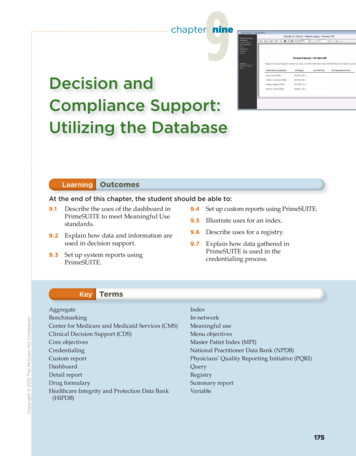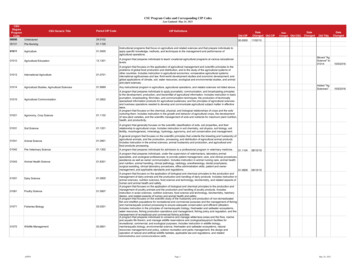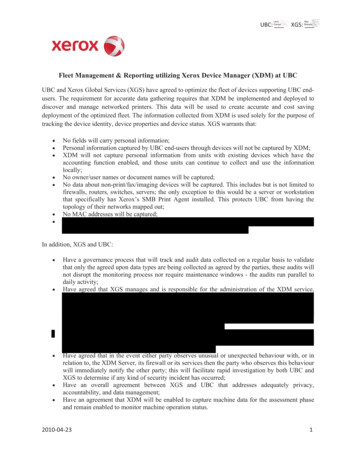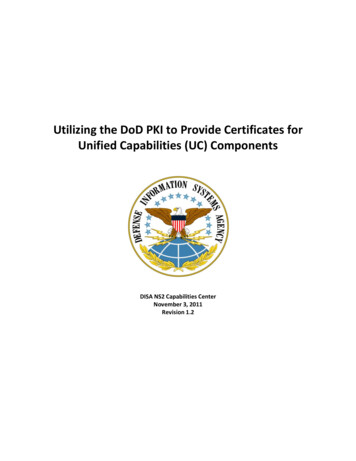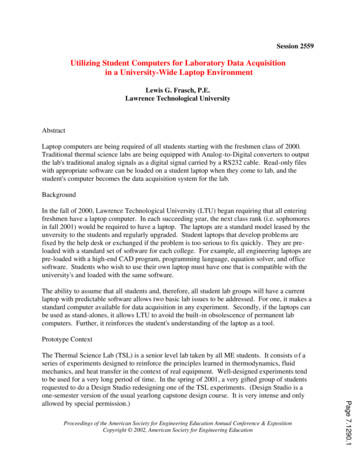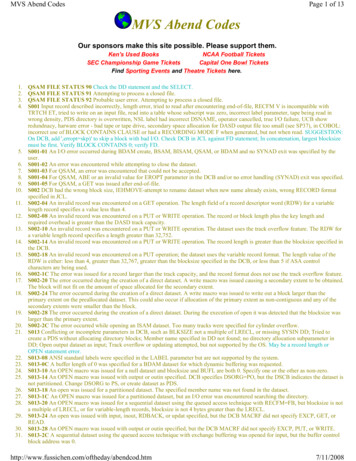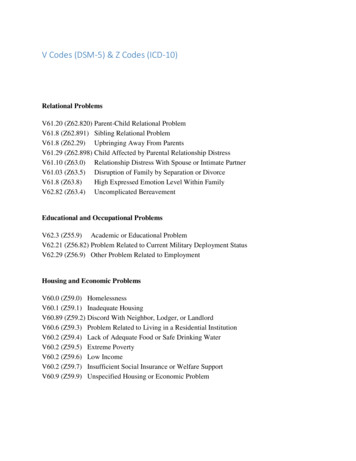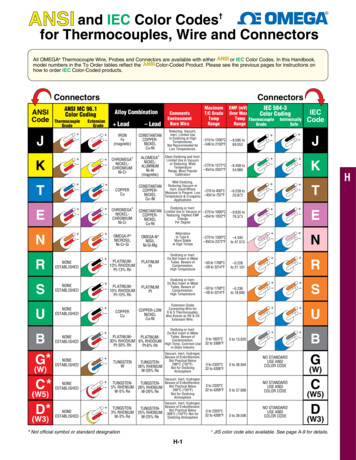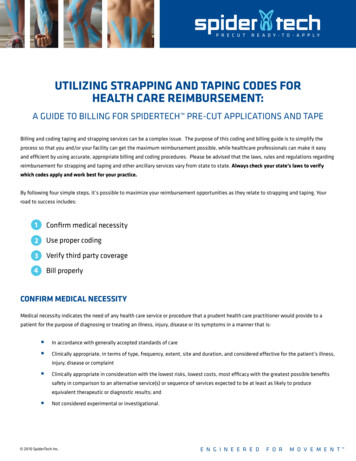
Transcription
UTILIZING STRAPPING AND TAPING CODES FORHEALTH CARE REIMBURSEMENT:A GUIDE TO BILLING FOR SPIDERTECH PRE-CUT APPLICATIONS AND TAPEBilling and coding taping and strapping services can be a complex issue. The purpose of this coding and billing guide is to simplify theprocess so that you and/or your facility can get the maximum reimbursement possible, while healthcare professionals can make it easyand efficient by using accurate, appropriate billing and coding procedures. Please be advised that the laws, rules and regulations regardingreimbursement for strapping and taping and other ancillary services vary from state to state. Always check your state’s laws to verifywhich codes apply and work best for your practice.By following four simple steps, it’s possible to maximize your reimbursement opportunities as they relate to strapping and taping. Yourroad to success includes:1Confirm medical necessity2Use proper coding3Verify third party coverage4Bill properlyCONFIRM MEDICAL NECESSITYMedical necessity indicates the need of any health care service or procedure that a prudent health care practitioner would provide to apatient for the purpose of diagnosing or treating an illness, injury, disease or its symptoms in a manner that is: In accordance with generally accepted standards of careClinically appropriate, in terms of type, frequency, extent, site and duration, and considered effective for the patient’s illness,injury, disease or complaint Clinically appropriate in consideration with the lowest risks, lowest costs, most efficacy with the greatest possible benefitssafety in comparison to an alternative service(s) or sequence of services expected to be at least as likely to produceequivalent therapeutic or diagnostic results; and Not considered experimental or investigational. 2010 SpiderTech Inc.E N G I N E E R E DF O RM O V E M E N T
A Guide to Billing / Health Care Reimbursements for SpiderTech 2In these situations, a service (therapeutic or diagnostic) is in accordance with this definition of “Medically Necessary Care” when all of thefollowing criteria are met: The patient has a symptom, impairment and/or disabilityThe service is not contraindicatedThe provider’s records include sufficient documentation to justify the serviceThere is a reasonable expectation that the service will result in a clinically significant level of improvement within areasonable time frame.Medical necessity is often accompanied by a diagnosis. For that reason, SpiderTech Pre-Cut Applications or SpiderTech Tape shouldalways accompany and follow a proper evaluation and appropriate ICD-9-CM Code accompanied with your diagnosis.Health care professionals that use SpiderTech Pre-Cut Applications and Tape know the necessity of strapping and taping and its benefits topatients. However, when the clinical record does not establish this medical necessity, it’s difficult to ascertain if third party reimbursementwill apply. Fabrication and application of strapping or taping (e.g., the use of elastic wraps, heavy cloth, adhesive tape) are used to enhanceperformance of tasks or movements, support weak or ineffective joints or muscles, reduce or correct joint limitations or deformities, and/orprotect body parts from injury. Splints and strapping are often used in conjunction with therapeutic exercise, functional training and otherinterventions, and should be selected in the context of the patient’s need and social/cultural environment. The health care professionaltargets problems in performance of movements or tasks, selects (or fabricates) the most appropriate support, fits the tape or othersupport, and trains the patient and/or caregiver(s) in its use and application. The goal is for the patient to function at a higher level bydecreasing functional limitations.1. History:Establish what conditions would warrant strapping and taping. When taking a patient history, be aware of the conditions reported whichmay benefit from the service. Look for ways in which the strapping and taping will help to restore the patient’s level of function. Someconditions commonly seen that would benefit from strapping and taping are:Repetitive Sprains and StrainsImproving Athletic PerformancePost-Operative Care and RehabilitationArthritic PainAcute Pain due to TraumaLower Back and Neck PainChronic Pain SyndromesShin SplintsPostural and Biomechanical ImbalancesRotator Cuff InjuriesBruising, Edema and SwellingPlantar Fasciitis 2010 SpiderTech Inc.
A Guide to Billing / Health Care Reimbursements for SpiderTech 2. Examination:During your examination, watch for signs and findings that could justify your strapping and taping service. For example, a patient maypresent with swelling or edema; the need to restrict certain ranges of motion without a hard end feel; or the need to decrease nociceptiveinput and pain. Findings like this can establish the necessity for taping.3. Written Treatment Plan:Once medical necessity is established, you must include the following components in your treatment plan: Recommended level of care plus frequency and duration of taping. Treatment(s) that you will use including the taping. Objective measures to evaluate the effectiveness of the taping.Some of the advantages of taping that could be included in the treatment plan as goals include: Improved feedback and timing of muscles controlling joint stability Decreased pain and enhanced functional stability Restoration of optimal muscle activation Improved performance Prevention of further injury Protection of tissues from tensile forces during healingDIAGNOSTIC CODESStrapping and taping can be medically necessary for a variety of conditions. The following is a list of diagnostic codes that, if appropriatefor your patient’s condition, could justify medical necessity for strapping and taping. This list is not meant to be all inclusive; please checkbenefit policy manuals to see what diagnosis codes are required.Note: The laws, rules and regulations regarding reimbursement for strapping and taping by health care professionals varygreatly from state to state. Always check your state’s laws to verify which codes apply and work best for your practice. 2010 SpiderTech Inc.3
A Guide to Billing / Health Care Reimbursements for SpiderTech DITION307.81Tension Headache339.20Post-traumatic Headache, unspecified724.2Low Back Pain648.70Pregnancy Backache716.9Chronic Arthritis847.2Lumbar Sprain/ Strain719.03Edema of Wrist722.52Degeneration of Lumbar Disc(s)959.6High Thigh Injury719.46Arthralgia of Knee715.96Degenerative Joint Diseaseof the Knee719.47Arthralgia of Ankle/Foot719.06Edema of Knee joint/Fibula/Patella/Tibia719.48Arthralgia of Cervical Spine/Thoracic Spine/Lumbar Spine840.6Supraspinatus (muscle) (tendon)sprain and strain781.2Abnormality of Gait(Ataxic, Paralytic, Spastic, Staggering)4APPLICATION OF STRAPPINGThe use of these codes apply when the strapping is a replacement procedure used during or after the period of follow-up care (usually postoperatively), or when the strapping is an initial service performed without a restorative treatment or procedure(s) to stabilize or protect afracture, injury, or dislocation and/or to afford comfort to a patient. Restorative treatment or procedures(s) rendered by another physicianfollowing application of the initial strap may be reported with a treatment of fracture and/or dislocation code.A physician who applies the initial strap and also assumes all of the subsequent fracture, dislocation, or injury care cannot use theapplication of the strapping codes as an initial service, since the fist strap application is included in the treatment of fracture and/ordislocation codes. A temporary strap is not considered to be part of the preoperative care, and the use of the modifier 56 is not applicable.Additional evaluation and management services are reportable only if significant identifiable further services are provided at the time ofthe strapping.If strapping is provided as an initial service (e.g., strapping of a sprained ankle or knee) in which no other procedure or treatment isperformed or is expected to be performed by a physician rendering the initial care only, use strapping and/or supply code (99070) inaddition to an evaluation and management code as appropriate.A few changes were made to the CPT Codes for 2010. Some Highlights are that 29220 – Strapping of Low Back was removed from thecoding System. To report Low back strapping, use 29799, Unlisted procedure, casting or strapping. 2010 SpiderTech Inc.
5A Guide to Billing / Health Care Reimbursements for SpiderTech CPT 2010 CODESEXAMPLES OF SPIDERTECH APPLICATIONS29200 - Strapping of ThoraxPostural SpiderLower Back SpiderLymphatic SpiderShoulder SpiderPostural SpiderLymphatic SpiderNeck SpiderAnkle SpiderElbow SpiderWrist SpiderLymphatic SpiderWrist SpiderLymphatic SpiderHip SpiderLymphatic Spider29240 - Strapping of Shoulder29260 - Strapping of Elbow or Wrist29280 - Strapping of Finger or Hand29520 - Strapping of HipE N G I N E E R E DF O RM O V E M E N T Groin Spider 2010 SpiderTech Inc.
6A Guide to Billing / Health Care Reimbursements for SpiderTech CPT 2010 CODESEXAMPLES OF SPIDERTECH APPLICATIONS29530 - Strapping of KneeFull Knee SpiderUpper Knee SpiderLymphatic SpiderCalf and Arch SpiderLymphatic SpiderAnkle SpiderHip Spider29540 - Strapping of Ankle and/or Foot29550 - Strapping of ToesAdapted from: American Medical Association. 2010 CPT (Current Procedural Terminology): Professional Edition. Chicago, IL 60654, American Medical Association, 2010.THERAPEUTIC PROCEDURESA manner of effective change through the application of clinical skills and/or services that attempt to improve function.Physicians or therapists are required to have direct (one-on-one) patient contact.CPT 2010 CODES97110 – Therapeutic procedure, one or more areas,SPIDERTECH APPLICATIONSANY SpiderTech Application or SpiderTape each 15 minutes; therapeutic exercises to developstrength and endurance, range of motion andflexibility97112 – Neuro-Muscular Re-Education ofANY SpiderTech Application or SpiderTape movement, balance, coordination, kinaestheticsense, posture, and/or proprioception for sittingand or/standing activities971533 – Sensory integrative techniques toenhance sensory processing and promote adaptiveresponses to environmental demands, direct(one-on-one) patient contact by the provider, each15 minutes 2010 SpiderTech Inc.ANY SpiderTech Application or SpiderTape
7A Guide to Billing / Health Care Reimbursements for SpiderTech SPIDERTECH APPLICATIONSCPT 2010 CODES97799 – Unlisted physical medicine/rehabilitationANY SpiderTech Application or SpiderTape service or procedure - specify97139 – Unlisted therapeutic procedure - specifyANY SpiderTech Application or SpiderTape 99070 – This is a miscellaneous code to be used forANY SpiderTech Application or SpiderTape supplies and material during an office visit.Adapted from: American Medical Association. 2010 CPT (Current Procedural Terminology): Professional Edition. Chicago, IL 60654, American Medical Association, 2010.REIMBURSEMENT OF PRODUCT USING 2010 HCPCS CODESThe HPCPS 2010 Codes can be used for SpiderTech Pre-Cut Applications or Spider Tech Tape in order to provide support or stabilization ofan extremity. These are NOT TIME BASED CODES. However the reimbursement amount has not been noted to be very high for this.HCPCS 2010 CODESSPIDERTECH APPLICATIONSA4452 – Tape, waterproof, per 18 square inchesANY SpiderTech Application or Unit Measure of SpiderTape A4452 x 3.2 units†Upper Knee Spider - 57 square inches†A4452 x 5.2 units†Full Knee Spider - 94 square inches†A4452 x 5.7 units†Calf & Arch Spider - 103 square inches†A4452 x 3.8 units†Shoulder Spider - 69 square inches†† HCPCS 2009 Code A4452 is a unit measure of 18 square inches. This is an approximate measurement for each of SpiderTech Application and should be used as a guide only.E N G I N E E R E DF O RM O V E M E N T 2010 SpiderTech Inc.
A Guide to Billing / Health Care Reimbursements for SpiderTech HCPCS 2010 CODES8SPIDERTECH APPLICATIONSA4452 x 2.9 units †Lower Back Spider - 52 square inches †A4452 x 3.3 units †Lymphatic Spider - 59 square inches †A4452 x 1.6 units †Medium Lymphatic Spider - 29 square inches †A4452 x 1 units †Small Lymphatic Spider - 18 square inches †A4452 x 1.8 units †Neck Spider - 32 square inches †A4452 x 2.9 units †Ankle Spider - 51 square inches †A4452 x 2.4 units†Hip Spider - 43 square inches†† HCPCS 2009 Code A4452 is a unit measure of 18 square inches. This is an approximate measurement for each of SpiderTech Application and should be used as a guide only.E N G I N E E R E DF O RM O V E M E N T 2010 SpiderTech Inc.
A Guide to Billing / Health Care Reimbursements for SpiderTech HCPCS 2010 CODES9SPIDERTECH APPLICATIONSA4452 x 2.2 units†Postural Spider - 40 square inches†A4452 x 2.5 units†Groin Spider - 45 square inches†A4452 x 3.2 units†Hamstring Spider - 58 square inches†A4452 x 2.9 units†Elbow Spider - 52 square inches†A4452 x 1.1 units† per sideWrist Spider - 20 square inches† per side† HCPCS 2009 Code A4452 is a unit measure of 18 square inches. This is an approximate measurement for each of SpiderTech Application and should be used as a guide only.VERIFY THIRD PARTY COVERAGEDon’t assume that strapping and taping is automatically a covered service with all third party payers. It’s crucial to verify insurancecoverage to determine whether this service is included in the patient’s benefits. Be sure to check with each individual carrier as well as yourstate scope of practice that may require certain diagnosis codes.The following are certain questions you may wish to include in your standard verification if you perform strapping and taping services foryour patients. 2010 SpiderTech Inc.
10A Guide to Billing / Health Care Reimbursements for SpiderTech Is strapping and taping, coded as 29XXX (give specific code), covered when billed by your professional designation, e.g., AthleticTherapist, Doctor of Chiropractic, Doctor of Osteopathic Medicine, Doctor of Medicine, Licensed Massage Therapist, OccupationalTherapist, or Physical Therapists (Doctor of Physical Therapy)? What is the allowable amount per code if this is performed? Do you have specific guidelines for the use of this code? Is a letter of medical necessity or pre-authorization needed or necessary? Are there certain diagnosis codes necessary for reimbursement?Add these questions to your usual verification sheet if you routinely perform strapping and taping.BILL PROPERLYWhen billing for strapping and taping, consider several important factors. The process of billing for strapping and taping is no differentthan any other clinical billing procedure. Appropriate medical necessity for the services rendered must be clearly identified. This sectionwill include information about diagnosis linking, a discussion of non-covered services, and an explanation of dealing with uninsured orunderinsured patients in need of taping and strapping for various conditions.PROPER BILLING TECHNIQUEThe relative value of the strapping and taping includes the cost of the tape application and the removal of the tape. Do not bill separatelyfor tape supplies or for the visit when you remove the tape. It is an inclusive procedure.DIAGNOSIS LINKINGThe strapping and taping services provided may be for a different functional goal and diagnosis. Therefore, in an effort to make thenecessity clear, using the 1500 billing form, link the strapping and taping service using box 24e to the diagnosis in box 21.1500 Billing form example: Box 21 is where you enter your ICD-9 diagnosis codes. Box 24D is where you enter your CPT codes. Box 24Eis where you enter the diagnosis reference number(s) 1, 2,3 or 4 as they relate to the 4 diagnoses code positions in Box 21. A writtendescription of your diagnosis codes in Box 21 is not necessary. Do not enter ICD-9 codes in Box 24E. You should try to fill all 4 positions inBox 21 (only if clinically indicated).NON-COVERED TAPING AND STRAPPING SERVICESSome carriers and contracts limit coverage for strapping and taping, or don’t cover it at all. If you are a participating provider on a plan, besure you’ve reviewed your contract and are clear about what your responsibilities are. If you find that strapping and taping is not a coveredservice on the plan, review what you’re able to pass that cost along to the patient. Your provider contract may forbid it, meaning theyexpect you to bundle the additional non-covered services into the covered ones. Otherwise, those costs can be passed along to the patienton a cash basis.E N G I N E E R E DF O RM O V E M E N T 2010 SpiderTech Inc.
11A Guide to Billing / Health Care Reimbursements for SpiderTech SpiderTech Inc. recommends to bill according to the cost of the product with a usual and customary merchandising mark up plus the costfor the health care practitioners time to apply and remove the strapping and/or tape.UNINSURED OR UNDERINSURED PATIENTSMany of your patients will need strapping and taping services, but will have no insurance or insurance that will not cover the service. Thismeans that many of your patients will pay cash for these services.It is reasonable to expect them to be willing to do so if they understand the importance of the strapping and taping in their treatment plan.However, it’s important to be clear about the boundaries. Make sure you do not offer non-compliant, discounted fees: When you havedifferent fees for the same service for different types of patients, it could be non-compliant. For example, your published fee schedule forstrapping and taping the knee (29530) is 65, but you wish to extend a time of service discounted fee of 30 uninsured or underinsuredpatients. This is outside the boundaries of what’s reasonable according to the Office of Inspector General of the Department of Healthand Human Services. Therefore, one easy way to be compliant is to join a cash discount network, which your patient can join, and then access adiscounted fee schedule of your choosing. Regardless of how you set your fees, be sure you are not in danger by offering non-compliant discounts.E N G I N E E R E DF O RM O V E M E N T 3370 Pharmacy Ave., Toronto, ON M1W 3K4 Tel: 416.490.4000 Fax: 416.490.4001 www.SpiderTech.com 2010 SpiderTech Inc.
Protection of tissues from tensile forces during healing DIAGNOSTIC CODES Strapping and taping can be medically necessary for a variety of conditions. The following is a list of diagnostic codes

